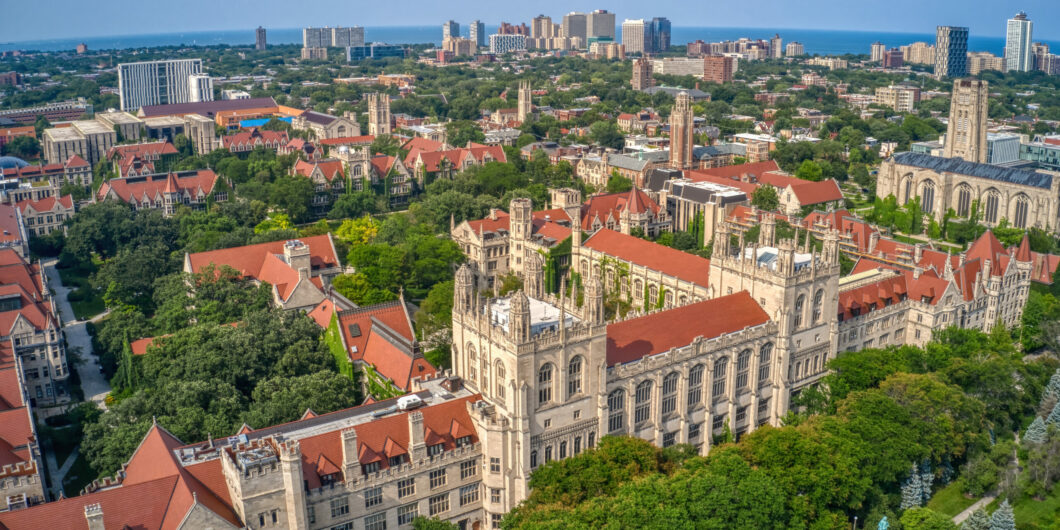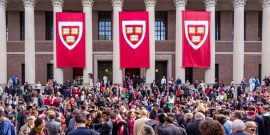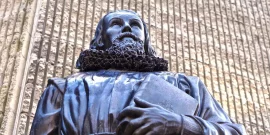Politics, Philosophy, and Economics programs are good examples of how to transmit the wisdom of Western civilization in the modern world.
The Next Step for Disaffected Donors
Americans’ confidence in our higher education system is at a historic low. According to a Gallup poll this summer, only 36 percent have real faith in our colleges and universities. After the ugly resurgence of antisemitism on campuses in the wake of Hamas’s attack on Israel, and some administrations’ inaction, many donors and alumni stand in open revolt. It is clear by now that American higher education is in crisis. To find solutions, funders must do more than close their checkbooks to institutions that have proven disappointing. They must also find ways to support the recovery of liberal learning, with its positive commitment to veritas—the Latin word for truth that is enshrined in the motto of Harvard and numerous other American universities.
Thirty-six years ago, Allan Bloom published The Closing of the American Mind, calling the crisis of liberal education “an intellectual crisis of the first magnitude, which constitutes the crisis of our civilization.” Bloom viewed the rise of moral and intellectual relativism in the university not only as a threat to the ideal of liberal education, but as a threat to democratic life in America. As he put it, “what is advertised as a great opening is a great closing. … No longer is there a hope that there are great wise men in other places and times who can reveal the truth about life.” Without a positive tradition to pass along to its students, in Bloom’s critique, institutions of higher education invited students to an institutional experience unmoored from any sense of higher purpose.
The degradation of American higher education was frustrating enough to the liberals who once managed it. The principles of liberalism—“belief in progress and the free market of ideas”—were replaced by “values” that “came on the winds.” These values were remarkable for their “thoughtlessness, the utter lack of need to argue or prove. Alternative views had no existence except as scarecrows.” The old project of the university—the quest to understand the nature and existence of the good—was long gone.
If Bloom’s famous critique resonated with classical liberals and academic conservatives in 1987 and beyond, it failed to reach or persuade millions of American alumni who continued to support their alma maters with massive annual donations, endowment gifts, and named buildings on campuses. Many alumni did read Bloom’s blistering critique—and still continued to give because there was still much to admire about the prestige and dynamism of American higher education.
Now, this winter—more than a generation after Bloom’s indictment—a nationwide, bipartisan movement of alumni and donors is taking form. Donors from every income bracket and every corner of the country are withdrawing support from colleges and universities.
Since the second week of October, many commentators have tried to explain how American higher education ended up in its current predicament. At issue is not only the extent to which antisemitism and other ideologies have found a home in academia, but the extent to which powerful faculty, administrators, and trustees have built this home. Only now are the American people fully seeing the breakdown that Bloom described, and that was evident to him in the armed student occupation of his own Cornell University nearly forty-five years ago.
The problem isn’t that ideologues hold a monopoly over higher education. Most who work in universities are deeply committed to their disciplines and their professional responsibilities, not to political activism. But according to University of Pennsylvania historian emeritus Alan Kors and attorney Harvey Silverglate, who co-founded the Foundation for Individual Rights and Expression (FIRE), “Universities are administered, above all, not by ideological zealots, but by careerists who have made a Faustian deal.” Many parts of campus—the athletic programs, the business department, the physics lab, the medical school, the fundraising office—remain non-ideological. These become the public face of the university in exchange for administrative protection of ideological activities within the institution, according to Kors and Silverglate.
No wonder many alumni and donors speak of feeling misled. Now, the game is up. The question is what donors committed to liberalism, and liberal education, should do next.
Facing financial pressures that were already mounting in the aftermath of the pandemic and growing generational questions about the value proposition of a college degree, university leaders—trustees, presidents, and senior administrators—are at a crossroads. They can set a new course in their institutions and assert the importance of the moral, intellectual, and civic virtues that are critical to the flourishing of a free society. They can commit to the foundational ideals of the liberal tradition while eschewing the rise of intolerant ideologies on their campuses. They can return the quest for truth and the good life to the center of the university’s mission. If they do these things, they may succeed in saving, even growing their universities—and hopefully, reopening the American mind to the wonders of intellectual life in the process.
Donors must find alternatives that honor the liberal tradition, a tradition that is vital to the ultimate recovery and resurgence of American higher education.
The opportunity is obvious for an established liberal arts college like Hillsdale College, just as it is for a new institution with big ambitions like the University of Austin.
However, sustainable reform must come through other means as well, and donors and alumni should seize the opportunity to influence the future of higher education at this critical moment.
Donors who seek reform should invest in established universities whose leaders are willing to take a stand for the liberal tradition in higher education. They might choose to support old institutions, including many religious colleges, that are conserving this tradition.
Alternatively, donors might redirect their money to any number of trade schools and technical colleges that are avoiding ideological corruption while providing a reliable pathway to the American Dream. They might donate to nearby community colleges. Such institutions are often well-attuned to local economic needs, focus on a practical agenda of teaching students over professorial research agendas, and serve a variety of learners—from high school students getting an early start on college credits to adults pursuing a degree later in life.
Funders might also support faculty-led centers within universities such as the 90 “Oases of Excellence” programs associated with the American Council of Trustees and Alumni. These institutions and centers like Princeton’s James Madison Program and Notre Dame’s Center for Citizenship & Constitutional Government “share a commitment to educating students for informed citizenship in a free society by maintaining the highest academic standards, introducing students to the best of the foundational arts and sciences, teaching American heritage, and ensuring free inquiry into a range of intellectual viewpoints.” Or donors might support humane fellowships for college students, such as the Fund for American Studies and the Hudson Institute’s Political Studies program.
Finally, funders should support efforts to strengthen the career pathway for university faculty and leadership who value the educational foundations of democratic citizenship. The Institute for Humane Studies, for instance, “supports the achievement of a free society by connecting and supporting graduate students, scholars, and intellectuals.” And the Jack Miller Center, a nonprofit, nonpartisan educational venture where I serve as president, is building a talent pipeline for academic scholars who value the American political tradition in history, political science, and related fields.
Several years after The Closing of the American Mind, historian Gertrude Himmelfarb described a possible opening for a return to wisdom and order in American universities, prompted by what she perceived as a spreading boredom within higher education. “Bored with trivia, with a specious relevance, with a smorgasbord of courses, with the politicization of all subjects and the fragmentation of all disciplines,” she wrote, “professors and students might welcome a return to a serious, structured curriculum and to a university that is an intellectual and educational, not a political or therapeutic, community.”
If boredom wasn’t enough to prompt a revolt, the outrages of this fall have been. But retreat is not enough. Donors must find alternatives that honor the liberal tradition, a tradition that is vital to the ultimate recovery and resurgence of American higher education.



